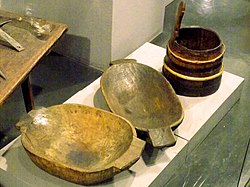Kaymak
This article has multiple issues.Please helpimprove itor discuss these issues on thetalk page.(Learn how and when to remove these template messages)
|
 Kaymak fromTurkey | |
| Alternative names | Malai |
|---|---|
| Course | Breakfastanddessert |
| Place of origin | Central Asia |
| Region or state | Iraq,Syria,Iran,India,Mongolia,Georgia,Albania,Greece,Lebanon,North Macedonia,Croatia,Serbia,Romania,Turkey,Egypt,Montenegro,Bosnia and Herzegovina,Afghanistan,Azerbaijan,Uzbekistan,Kazakhstan,Pakistan,India. |
| Main ingredients | Milk |
| Variations | Kaymer, Qaymer, Qeimer, Qaymiq, Qashta, Ashta, Makahan |
Kaymak,sarshir,orqashta/ashta(Persian:سَرشیرSaršir;Arabic:قشطةQeshtaorقيمرGeymar), is a creamydairy foodsimilar toclotted cream,made from themilkofwater buffalo,cows,sheep,orgoatsinCentral Asia,someBalkancountries, someCaucasuscountries, the countries of theLevant,Turkicregions,IranandIraq.InPoland,the namekajmakrefers to a confection similar todulce de lecheinstead.[1]
The traditional method of making kaymak is to boil the raw milk slowly, then simmer it for two hours over a very low heat. After the heat source is shut off, the cream is skimmed and left to chill (and mildlyferment) for several hours or days. Kaymak has a high percentage ofmilk fat,typically about 60%. It has a thick, creamy consistency (not entirely compact, because of milk protein fibers) and a rich taste.[2]
Etymology[edit]
The wordkaymakhasCentral AsianTurkicorigins, possibly formed from the verbkaymak,which means 'melt' and 'molding of metal' inTurkic.[3]The first written records of the wordkaymakis in the well-known book ofMahmud al-Kashgari,Dīwān Lughāt al-Turk.The word remains askaylgmakin Mongolian, which refers to a friedclotted cream,and with small variations in Turkic languages asqaymaqinAzerbaijani,qaymoqinUzbek,қаймақinKazakhandShor,каймакinKyrgyz,kaymakinTurkish,[3]gaýmakinTurkmen,კაიმაღი(kaimaghi) inGeorgian,καϊμάκι(kaïmáki) inGreek,andкајмак(kajmak) inSerbo-Croatian,caimacinRomanian.This dairy food is calledsarshir(سَرشیر) in Iran. This word means 'top of the milk'. They use this name because after boiling milk, a layer of fat stands on the top of the boiled milk.[4][5]
Turkey[edit]

Shops inTurkeyhave been devoted to kaymak production and consumption for centuries. Kaymak is mainly consumed today for breakfast along with the traditionalTurkish breakfast.One type of kaymak is found in theAfyonkarahisarregion where the water buffalo are fed from the residue of poppy seeds pressed for oil. Kaymak is traditionally eaten withbaklavaand otherTurkish desserts,fruit preserve and honey or as a filling inpancakes.[citation needed]
Balkans[edit]


Known askajmak,it is almost always made at home, though commercial production is on the rise. Kajmak is most expensive when freshest—only a day or two old. It can keep for weeks in the refrigerator but becomes harder and loses quality.[6]Kajmak can also be matured in dried animal skin sacks; one variation is calledskorup.Kajmakalso describes the creamy foam in the Turkish coffee, and a lot of other coffees in the Balkans.
It is usually enjoyed as anappetizeror for Saturday morning breakfast, as Saturdays are market days with the best kajmak, but also as acondiment.The simplest recipe islepinja s kajmakom(pita breadfilled with kajmak), consumed for breakfast or asfast food.Bulgarians,Bosnians,MontenegrinsandSerbs,Albaniansconsider it a national meal. InAlbanianit's called ajkë. Other traditional dishes with kajmak (sold in restaurants) includepljeskavicas kajmakom(theBalkanhamburger patty topped with melted kajmak), as well asribić u kajmaku(beef shank, simmered with kajmak).[citation needed]
Iraq[edit]
InIraq,it is calledgeymarorqeimar(قيمر) and is very popular. Iraqigeymaris usually made from the rich fatty milk of cows or buffaloes, which are prevalent in the marshes of southern Iraq. It is available both factory-produced and from local vendors or farmers asgeymar Arab.[citation needed]
Iraqis tend to servegeymarfor breakfast with bread, honey or jam. The most popular way is to spread it on a type of Iraqi pastry bread calledkahiand cover it withdate honey.Qeymaronkahiwith date syrup or honey is a long-standing traditional breakfast in Baghdad and throughout southern and northern Iraq.[citation needed]
Iran[edit]
InIran,sarsheer(سرشیر) is used to describe a different method which does not involve heating the milk, thus keeping enzymes and other cultures of the milk alive.
Afghanistan[edit]
InAfghanistan,qaimakorqaymaqhas a thinner quality and is eaten for breakfast meals usually with bread. People typically top qaimak with honey, sugar, or mix it with jam. It can be spread on pastries or added to milk tea. Qaimak can be purchased at grocery stores in Afghanistan or made at home. While a lot qaimak variations are made from buffalo milk, Afghan qaimak can be made from cows' milk.
Georgia[edit]

In theAdjararegion ofGeorgia,bordering Turkey,კაიმაღი(kaimaghi) is made from cow's milk in homes in the mountainous municipalities ofKeda,Shuakhevi,andKhulo.It is typically eaten withGeorgian cheeseand/or bread, and is only rarely served in restaurants.[citation needed]
Greece[edit]
Kaïmaki(καϊμάκι) is a soft cream cheese that can be spread on bread or used in cooking as a filling in food and for desserts. Kaïmaki can also be found as a chewy ice cream that is flavoured withmastic.[citation needed]
See also[edit]
Citations[edit]
- ^"Polish Chocolate and Dulce de Leche Mazurek".Polish Your Kitchen.9 April 2017. Archived fromthe originalon 29 June 2021.Retrieved27 February2021.
- ^"Kaymak Recipe".24 January 2021.Retrieved12 August2021.
- ^ab"kaymak"(in Turkish). Nişanyan Sözlük.Retrieved13 July2017.
- ^(in Romanian)https://laptariacucaimac.ro/.Retrieved2022-02-02.
{{cite web}}:Missing or empty|title=(help) - ^"kaymak in Romanian".English–Romanian Dictionary.Glosbe.Retrieved2022-02-02.
- ^Vrzić, Nikola (December 28, 2000)."Sve srpske kašike"(Windows-1250).NIN(in Serbian).Retrieved13 June2012.
References[edit]
- The Poppy Growers of İsmailköy (2002)
- Davidson, Alan. Oxford Companion to Food (1999). "Kaymak", pp. 428–429.ISBN0-19-211579-0
- An Introduction into the Serbian Cuisine
External links[edit]
![]() Media related toKaymakat Wikimedia Commons
Media related toKaymakat Wikimedia Commons

